Derby Tourist Attractions and Sightseeing
(Derby, Derbyshire, England, UK)
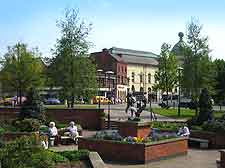
Many of the main tourist attractions in Derby stand within the attractive Cathedral Quarter, which is located in the city centre and brimming with places to shop, eat and stay. Tourists often pay a visit to the Royal Crown Derby Factory and its bone-china attractions, or enjoy an afternoon boat trip down the Derwent River, while others come to the city to watch a game of football at the outlying Pride Park Stadium.
In total, there are more than 300 existing green spaces in Derby, with one of the biggest and most popular being the city's arboretum. A vast landscaped parkland and tourist attraction in its own right, the Derby Arboretum was actually the very first publicly owned recreational park in the whole of
England. This arboretum was actually donated to the city by former mayor Joseph Strutt (1765 to 1844), who wished to share his wealth and good fortune with the local residents.
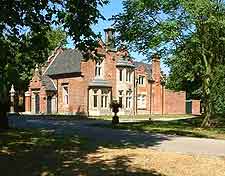
Derby Arboretum
Address: Rose Hill, Derby, Derbyshire, England, UK
Many different buildings and statues have graced the park over the years, and the recently restored Grove Street Lodge is especially notable and graced the Grand Entrance, on the northerly side of the park. Other attractions in the park include a children's playground, a wildlife garden, the Heart of the Park community centre, and of course, a large collection of mature trees and shrubs from all over the world. The Derby Arboretum was later extended and now stands alongside the Rode Hill Recreation Ground, where many local community events take place on its sports field, particularly during the summer months.
Open hours: daily - 08:00 to 18:00
Admission: free
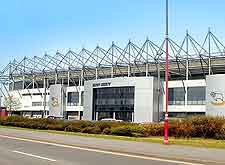
Pride Park Stadium
Address: Royal Way / Derwent Parade, Pride Park, Derby, Derbyshire, DE24 8XL, England, UK
A sizeable football stadium located on the outskirts of the city, the Pride Park Stadium is the official home of the Derby County FC. Capable of accommodating just under 35,000 spectators, the Pride Park Stadium was opened in the summer of 1997 by Queen Elizabeth II, being built as a replacement to the city's historic late 19th-century Baseball Ground. As well as hosting sporting events, the stadium also occasionally plays host to large rock and pop concerts.
Open hours: hours vary
Admission: charge for events
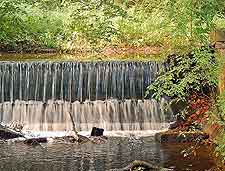
Markeaton Park and Light Railway
Address: Markeaton, Derby, Derbyshire, England, UK
Markeaton Park is an extremely popular leisure attraction and is to be found in the Markeaton suburb of Derby. A number of attractions are based here, including the late 18th century Markeaton Hall, a duck pond, a playground and pathways. However, it is the 381 mm / 15 inch gauge railway that has become the biggest draw card here. This railway line stretches just over 1.2 km / 0.75 miles and operates as a charitable trust, being maintained by local volunteers and featuring small diesel powered locomotives, which have now replaced the former steam train known as the Markeaton Lady. Each year at the beginning of November, Markeaton Park serves as the city's main venue for its yearly fireworks display as part of the Guy Fawkes Night celebrations.
Open hours: daily
Admission: charge for light railway with discounts for children, park free
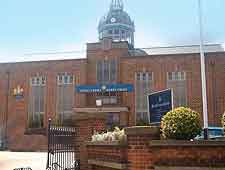
Royal Crown Derby Factory
Address: 194 Osmaston Road, Derby, Derbyshire, DE23 8JZ, England, UK
Tel: +44 01332 712800
The factory for the city's famed Royal Crown Derby is located on Osmaston Road, where it produces some of England's finest quality bone china. Admission to the factory is completely free, and once inside, you are able to observe the skillful potters at work, creating highly detailed china flowers and elaborate decorations. The onsite factory shop is brimming with teapots of all shapes and sizes, as well as some bargain quality seconds, official Royal Crown Derby paperweights and other collectibles. For a small charge, guided tours of the factory are available and provide an insight into the full production process, from raw powder and the mixing process, right up to the final decorations, using liquid gold.
Open hours: Monday to Saturday - 09:00 to 17:00, Sunday - 10:00 to 16:00
Admission: free
Derby Canal
Address: Derby, Derbyshire, England, UK
In its heyday, the Derby Canal stretched for some 23 km / 14 miles, connecting the canals at Sandiacre and Swarkestone. Built over a three-year period in the late 18th century, the canal was used primarily to transport coal around the Derbyshire area. The canal enjoyed a brief success and many problems, including the need for much strengthening work to be carried out on the cast-iron aqueduct, which began to bow outwards. With the arrival of trains in the 19th century and increasing tolls, the Derby Canal became less and less popular, and eventually closed completely in 1964. Today, the route of the original canal can be traced to some extent and much of this waterway has now been completely restored, thanks in no small part to the efforts of the Derby and Sandiacre Canal Society. The historic weir forming the Derwent Basin is also still very much in evidence and worth looking out for.
Open hours: daily
Admission: free
 Many of the main tourist attractions in Derby stand within the attractive Cathedral Quarter, which is located in the city centre and brimming with places to shop, eat and stay. Tourists often pay a visit to the Royal Crown Derby Factory and its bone-china attractions, or enjoy an afternoon boat trip down the Derwent River, while others come to the city to watch a game of football at the outlying Pride Park Stadium.
Many of the main tourist attractions in Derby stand within the attractive Cathedral Quarter, which is located in the city centre and brimming with places to shop, eat and stay. Tourists often pay a visit to the Royal Crown Derby Factory and its bone-china attractions, or enjoy an afternoon boat trip down the Derwent River, while others come to the city to watch a game of football at the outlying Pride Park Stadium.


